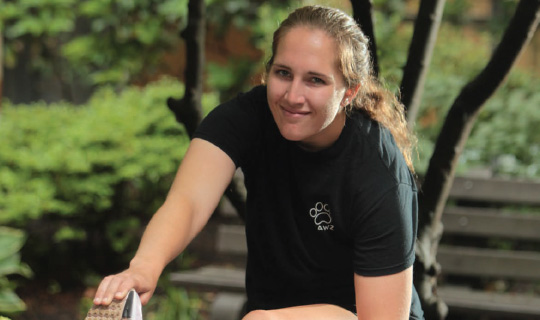"I’m stronger both physically and mentally."

In addition to her responsibilities as a student athlete, Theresa was a member of the Reserve Officer Training Corps (ROTC), a college program that trains students to become commissioned officers in the military. Theresa feared the injury could compromise her long-held dream to serve her country. “I was scared I wouldn’t be able to commission [become an officer in the U.S. Army],” she says.
A more serious diagnosis
One month later, Theresa was still in pain, and she had trouble bending her knee. She had a magnetic resonance imaging (MRI) scan at a hospital near the university, and it revealed that she had actually torn the anterior cruciate ligament (ACL) and the meniscus in her left knee. (See “Common Knee Injuries, below.”) When she was home in Bayville over Christmas break, Theresa saw David Dickerson, MD, an orthopedic surgeon at Community Medical Center (CMC). He reviewed the MRI scan and recommended ACL reconstruction with an autograft, in which the ligament is replaced with tissue from the body. For the meniscus, Theresa needed a medial meniscal repair, in which the torn meniscus is stitched back together, and a partial lateral meniscectomy, in which damaged tissue is removed.
Fortunately, all of the procedures could be done in one outpatient surgery. Theresa was nervous because she’d never had surgery before, but she was eager to recover because she needed medical clearance to serve in the Army. In January 2018, Theresa had the surgeries. Dr. Dickerson used Theresa’s hamstrings to reconstruct her ACL. “Most young people, particularly athletes with well-developed muscles and tendons, have enough of their own tissue for an adequate graft,” he says.
Back in action
After the surgery, Theresa wore a brace that kept her leg straight for six weeks. She participated in physical therapy, which involved strengthening her quadricep and hamstring muscles and performing balance and endurance exercises. The hard work and determination paid off. “She did great,” says Dr. Dickerson. “She was essentially asymptomatic five months later and back to nearly all of her usual activities seven months later.”
In June 2018, Dr. Dickerson cleared Theresa for all activities, including rugby. She cried tears of happiness. She graduated from college in May 2018 and shipped out to Colorado to start her job as a second lieutenant transportation officer in the U.S. Army. She oversees a maintenance platoon of soldiers who repair vehicles and weapons and recently deployed to Kuwait.
Theresa’s injury has been life-changing. During her recovery from surgery, she pushed herself in ways she had not done before. “I’m stronger both physically and mentally,” she says.
Common knee injuries
People of all ages experience knee injuries—especially those involving the anterior cruciate ligament (ACL), which controls back and forth motion of the knee, and the meniscus, cartilage that cushions the joint. These tissues provide stability and are often torn in sports that involve sudden stops and changes in direction. Injuries can also occur as a result of aging (the tissue can deteriorate over time).
ACL injuries affect up to 250,000 people each year in the U.S., according to the Centers for Disease Control and Prevention. Meniscus tears, which often occur along with ACL injuries, affect 12 to 14 percent of the population, according to the American Academy of Physical Medicine and Rehabilitation.
Symptoms of an ACL tear include pain with swelling; loss of full range of motion; tenderness; and discomfort while walking. Signs of a meniscus tear include knee pain, stiffness, swelling, locking of the knee, and difficulty moving the knee. If you experience any of these symptoms, see a physician.
For more information about a referral to a Community Medical Center orthopedic surgeon, call 888.724.7123..